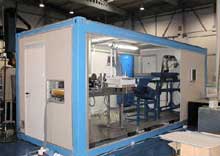`Artificial vision` for recycling copper

It’s in this machine where they recover copper from old cables
The technological centre Robotiker from Zamudio (Basque Country) has developed a system of artificial sight to separate metals that come with copper, in order to obtain high purity copper.
To recover copper from old cables it is not something new. However, the recycled copper is not pure, because it is mixed with other metals, such as lead, aluminium and tin. It is quite complicated to separate copper from those components by using mechanical, physical and other methods. Nevertheless it is easy to distinguish impurities through the eyesight.
The recycling of cables has been promoted by the need to change conventional telephone lines. The price of the material obtained from the recycling of electrical and telephone cables depends on the level of purity of the copper. Therefore, the fact of having lead, aluminium and tin along with copper determines the use and, hence, the price of copper.
With the system developed by Robotiker, after several processes the copper cable is divided into small pieces, and that divided copper has a purity of 99 %. The size of those pieces is variable, but usually it has 8-15 mm long, 3-1 mm wide and 1 mm high. When those pieces of the cable go along a belt, a camera with artificial sight can see them and differ them by the colour. If it realises it is not copper, it will reject it.
When copper has a purity of 99 %, it is used for plumbing and heating-systems. However, if it is going to be recycled for electrical use, its purity must be at least of 99.9 %. Thanks to the high purity obtained at the end of this new process, copper can be used for electrolytic processes, that is, for batteries. That was the aim of the companies that have developed the project together with Robotiker; more precisely the aim of Laining Industrial and two companies from the recycling sector Indumental Recycling and Botrade.
Thanks to this leading technique of artificial sight, materials can be separated by colour and shape. The result of this project (reduction of impurities from 10 to 1 with 1,000 Kg/hour flows) allows to expand in future such systems to other recycling processes.
Media Contact
More Information:
http://www.basqueresearch.com/index.asp?Gelaxka=1&hizk=IAll latest news from the category: Process Engineering
This special field revolves around processes for modifying material properties (milling, cooling), composition (filtration, distillation) and type (oxidation, hydration).
Valuable information is available on a broad range of technologies including material separation, laser processes, measuring techniques and robot engineering in addition to testing methods and coating and materials analysis processes.
Newest articles

Superradiant atoms could push the boundaries of how precisely time can be measured
Superradiant atoms can help us measure time more precisely than ever. In a new study, researchers from the University of Copenhagen present a new method for measuring the time interval,…

Ion thermoelectric conversion devices for near room temperature
The electrode sheet of the thermoelectric device consists of ionic hydrogel, which is sandwiched between the electrodes to form, and the Prussian blue on the electrode undergoes a redox reaction…

Zap Energy achieves 37-million-degree temperatures in a compact device
New publication reports record electron temperatures for a small-scale, sheared-flow-stabilized Z-pinch fusion device. In the nine decades since humans first produced fusion reactions, only a few fusion technologies have demonstrated…





















